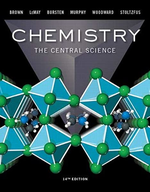?The ionic compound CaO crystallizes with the same structure as sodium chloride (Figure
Chapter 8, Problem 8.82(choose chapter or problem)
The ionic compound CaO crystallizes with the same structure as sodium chloride (Figure 8.3).
(a) In this structure, how many O2- are in contact with each Ca2+ ion (Hint: Remember the pattern of ions shown in Figure 8.3 repeats over and over again in all three directions.)
(b) Would energy be consumed or released if a crystal of CaO was converted to a collection of widely separated Ca—O ion pairs?
(c) From the ionic radii given in Figure 7.8, calculate the potential energy of a single Ca—O ion pair that is just touching (the magnitude of electronic charge is given on the inside back cover).
(d) Calculate the energy of a mole of such pairs. How does this compare to the lattice energy of CaO?
(e) What factor do you think accounts for most of the discrepancy between the energies in part
(d)—the bonding in CaO is more covalent than ionic, or the electrostatic interactions in a crystal lattice are more complicated than those in a single ion pair?
Unfortunately, we don't have that question answered yet. But you can get it answered in just 5 hours by Logging in or Becoming a subscriber.
Becoming a subscriber
Or look for another answer
